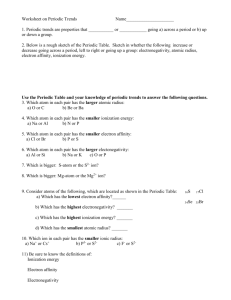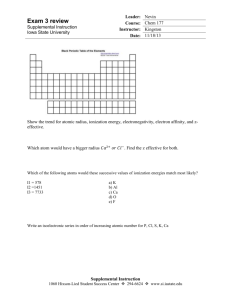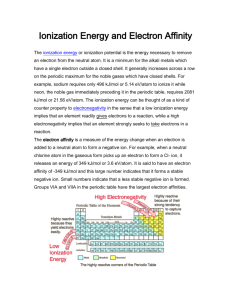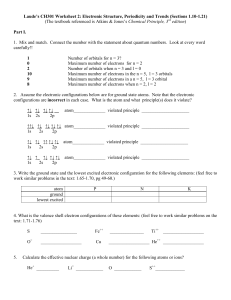Families on the Periodic Table
advertisement
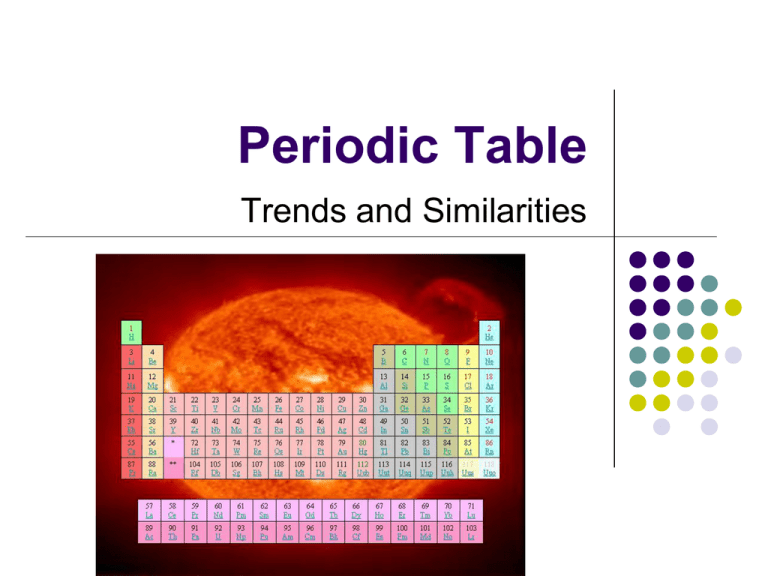
Periodic Table Trends and Similarities Trends of the Periodic Table: At the conclusion of our time together, you should be able to: 1. Give a trend across and down the Periodic Table for metallic characteristics, reactivity, atomic radius and ion radius, electron affinity, ionization energy, and electronegativity. 2. Pick the element with the higher trend above from a list of several elements Trends In The Periodic Table: Ionization Energy Atomic Radius Electron Affinity Electronegativity, Etc. Atomic Radius Trends – Page 13 Left to Right: Decreases Top to Bottom: Increases Ionization Energy Trends – Page 13 Left to Right: Increases Top to Bottom: Decreases Electronegativity Trends – Page 13 Left to Right: Increases Top to Bottom: Decreases Electron Affinity – Page 13 (Add to Page 13) Left to Right: Increases Top to Bottom: Decreases Atomic Radius – Page 14 ½ the distance between the nuclei of two identical atoms that are bonded together. Trends Explanation – Page 14 Electron-electron repulsion makes radius larger, very weak interactions. 1. Proton – electron attraction = smaller atom 2. Explains all trends going across a period Energy level, n (distance from the nucleus), as they go higher = larger atom 3. Explains all trends going down a group Ionization Energy – Page 14 The energy (effort) required to remove one electron from a neutral atom. Left to Right: Increases The closer to the nucleus, the harder to take an electron away. Top to Bottom: Decreases The farther away from the nucleus the easier it is to take an electron away. Electronegativity – Page 14 A measurement of the ability of an atom in a chemical compound to attract electrons. (how strongly an atom holds onto its own electrons and how strongly it needs another electron) Most electronegative element – Fluorine (F) Electron Affinity – Page 14 The energy change that occurs when a neutral atom acquires an electron. Energy is released from the atom. Atoms that really want another electron tend to release more energy. Ionic Radius Trends – Page 15 Less e repulsion = smaller radius More e repulsion = larger radius Reactivity Trends metals ….Francium nonmetals …Fluorine Top to Bottom Left to Right Increases with Metals Decreases with Nonmetals Decreases with Metals Increases with Nonmetals Atomic Radius Trends Top to Bottom Left to Right Increases (larger size atom) Decreases (smaller size atom) Ionization Energy Trends Top to Bottom Left to Right Decreases Increases Electron Affinity Trends Top to Bottom Left to Right Decreases (less energy released) Increases (more energy released) Noble Gases = 0 Electronegativity Trends Top to Bottom Left to Right Decreases Increases Metallic Character 1. 2. 3. 4. 5. Low ionization energy Low electronegativities High luster – shiny Good conductor or electricity and heat Malleable and ductile Most metallic element = Francium Non Metallic Character 1. 2. 3. 4. 5. High ionization energy High electronegativities Little or no metallic luster Poor electrical and thermal conductors Fewer solids Most nonmetallic element = Fluorine Metalloid Character 1. Characteristics of both metals and nonmetals 2. Electronegativities between those of metals and nonmetals 3. Ionization energies between those of metals and nonmetals. 4. Boiling pts, Melting pts and Densities vary widely
